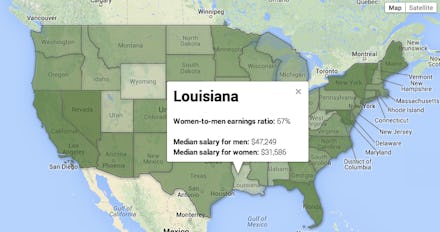In Every Single State Women Make Less Than Men — See For Yourself

The news: It's 2014, but some things never change: in every single state in the U.S., women earn less than men.
The wage gap between men and women has narrowed since the '70s, but not by enough. On average, women still make only 77% of what men make, despite the fact that women now nearly outnumber men in the non-agricultural workforce. To this day, men earn a median salary of $49,398, while the average woman only makes $37,791 a year. There's been some progress, but there's still a long way to go.
Image Credit: AAUW
In certain states, that gap is shocking. The state with the widest discrepancy is Wyoming, where the average woman only makes 64% of the average man's salary. States like Maryland, Nevada and Vermont have much narrower gaps (Washington D.C. has women making 90% of men's salary), but they are the exceptions in a grim landscape.
Alabama, Mississippi, South Carolina, Utah and Wisconsin don't even have fair pay laws — and surprise, surprise, they can't cross the 80% threshold.
But don't take our word for it. Click through this interactive map to see how your state fares in closing the gap between men and women:
And here is a ranking of the states, from smallest to biggest wage gap:
Image Credit: AAUW
So what exactly contributes to this persisting wage gap? Skeptics believe that the figures above don't take into account other factors, such as age, race, education and occupation. After all, it's not as though every woman who does the same exact job as a man earns 23% less than her male counterpart. Men just happen to congregate in higher-paying industries, so that doesn't mean everyone is sexist, right?
The implications of that statement are troubling enough: it's harder for women to break into traditionally male-dominated fields, there's a lack of female recruitment in these industries, traditionally female jobs have a pay ceiling, inadequate maternity policies force women to take breaks, et cetera, et cetera. All of this is true. But what this can't explain is how even when these factors are controlled, the wage gap still exists.
The fact is, more women are graduating college than men, and make up more than half of America's technical and professional workforce. But even under identical circumstances, on average, a woman only makes 91% of what a man does — and there is no explanation for that, except the obvious one: sexism.
Image Credit: AAUW
Image Credit: AAUW
Image Credit: AAUW
Image Credit: AAUW
The bottom-line: No matter how you parse it, the wage gap is real. And not only does it adversely affect women, it impacts the majority of American families. In 2010, two-thirds of households had a woman as the breadwinner or a co-breadwinner, yet mothers earned 7% less per child than childless women did. Over 40 years, the accumulated difference between men's and women's age can amount to $431,000 — seriously restricting a family's income growth (the gap only grows wider as women grow older). So if anyone has a good explanation this, we'd love to hear it.